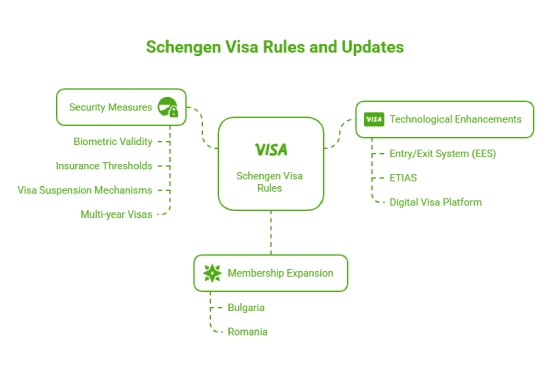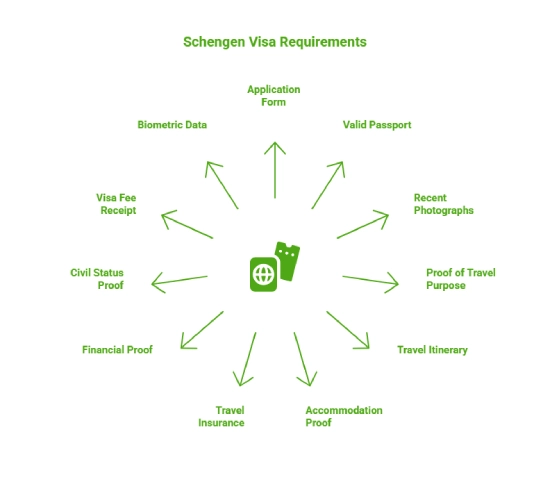.webp)
A Schengen Visa is a short-term visa that allows non-EU nationals to travel freely within the Schengen Area, which includes 29 European countries. It permits stays of up to 90 days within any 180-day period for purposes such as tourism, business, or family visits. With a Schengen Visa, you can enter any member country and move across borders without internal checks. It is one of the most convenient visas for exploring Europe on a single trip. The visa must be applied for at the embassy or consulate of the main destination country.
The Schengen Visa system categorizes visas into different types depending on the purpose and duration of travel. Below are the official visa types:
This visa allows travelers to transit through the international transit area of airports in Schengen countries without entering the Schengen territory. It is mandatory for citizens of specific countries when changing flights within the Schengen Area.
Previously used for short land or sea transits through Schengen countries (up to 5 days). This visa type has largely been phased out and is now typically covered under Type C short-stay visas with limited validity.
The most common visa type, allowing stays of up to 90 days in any 180-day period for tourism, business, family visits, or similar short-term purposes. It can be issued as:
Issued by individual Schengen states for stays exceeding 90 days. This visa is typically granted for purposes such as study, employment, or long-term family reunification and may allow travel within the Schengen Area under certain conditions.
.webp)
The Schengen Area is a zone of 29 European countries that have abolished internal border controls, allowing free and unrestricted movement of people. A Schengen Visa allows you to travel across all these countries with a single visa.
Whether you are visiting for tourism, business, or family reasons, your visa is valid in any of the member states listed below:
Note: The United Kingdom is a European country but is not part of the Schengen Area. UK citizens or residents traveling to Schengen countries must apply for a Schengen Visa (unless visa-exempt based on nationality).
*Want to visit abroad? Let Y-Axis assist you with the procedure.
The Schengen Visa rules are governed by the EU Visa Code and have been enhanced in 2025 to strengthen security and streamline procedures. Here are the key updates:
As of January 1, 2025, both countries are fully integrated into the Schengen Zone—visa holders can now cross all borders seamlessly.
Manual passport stamping will be replaced by biometric data (fingerprints + photo) and entry/exit tracking via EES.
From late 2025 to early 2026, travelers from visa-free countries (e.g. UK, US, Australia) will need a pre-travel ETIAS authorization (€7 fee, valid for 3 years).
EU is introducing a unified digital application platform via eu-LISA by 2026–2027, with full implementation by 2028.
Biometric data will now be valid for 59 months, and minimum travel insurance coverage is being reviewed upward.
New rules allow rapid, decisive visa-policy sanctions against third countries in response to security threats, migration surges, or misuse of visa-free regimes.
Frequent applicants may now receive long validity multiple-entry visas up to 1, 3, or 5 years under the new “visa cascade” rule.

Some of the benefits of applying for a Schengen visa are as follows:
To qualify for a Schengen Visa, you must:
The requirements for a Schengen visa are as follows:

You can follow the below steps to apply for a Schengen visa:
Step 1: Determine the visa type and main destination
Step 2: Check eligibility and gather required documents
Step 3: Schedule an appointment at the relevant embassy or visa centre
Step 4: Submit the application and biometrics
Step 5: Pay the visa fee
Step 6: Wait for application processing
Step 7: Collect your passport with the visa decision
The standard processing time for a Schengen Visa is up to 15 calendar days from the date of application submission. However, depending on your individual case or additional document checks, it may take up to 30 or 60 days.
The table below has a breakdown of the Schengen visa fees:
| Type | Cost |
| Adult | € 90 |
| Children aged 6 to 12 | € 45 |
| Children under age 6 | Free |
As the leading overseas immigration consultancy in the UK, Y-Axis has been providing dedicated immigration assistance to its customers for more than 25 years. Our team of visa and immigration experts will give end-to-end guidance for all your immigration needs:
The countries covered in the Schengen visa are listed below:
As of 2025, Bulgaria and Romania are part of the Schengen Area for air and sea travel, with full land border integration pending.
The Schengen Visa is issued in several types, based on purpose and duration:
Note: These are further categorized into single-entry, double-entry, or multiple-entry visas.
As of June 11, 2024, the standard Schengen Visa (Type C) fees are:
Note: These fees apply equally to all Schengen countries and are non-refundable.
No, a Schengen Visa does not permit employment. It is strictly for short stays such as tourism, business visits, or family travel. If you intend to work in a Schengen country, you must apply for a National Visa (Type D) or a work permit issued by that country, depending on your employment situation.
To apply for a multiple-entry Schengen Visa, you must indicate this preference in your application and provide evidence of frequent or planned travel. Multiple-entry visas are often granted to applicants with a solid travel history, valid reasons for return, and sufficient financial means. Depending on your visa history, you may be eligible for a 1-year, 3-year, or 5-year multi-entry visa under the “visa cascade” system.
The “90/180 rule” means you can stay in the Schengen Area for up to 90 days within any 180-day period. This includes cumulative stays across all member countries. Overstaying this limit can lead to fines, entry bans, or visa refusal in the future. Use official tools like the Schengen Calculator to monitor your stay.
To apply for a Schengen Visit Visa (Type C), you need:
With a valid Schengen Visa, you can travel to all 29 Schengen Area countries. These include popular destinations like France, Germany, Italy, Spain, and more. Once you enter through the first country of entry, you can move freely between member states without internal border checks.
A Schengen Tourist Visa is valid for up to 90 days within a 180-day period. The actual length of stay and validity depends on the visa type (single, double, or multiple-entry) and the decision of the consulate. You cannot exceed the 90-day limit, even if you hold a multiple-entry visa.
The standard processing time for a Schengen Visa is up to 15 calendar days after submitting your application. In some cases, it may take up to 30 or 60 days if additional documents or further checks are needed. Applicants are advised to apply at least 15 days and no more than 6 months before the intended travel date.